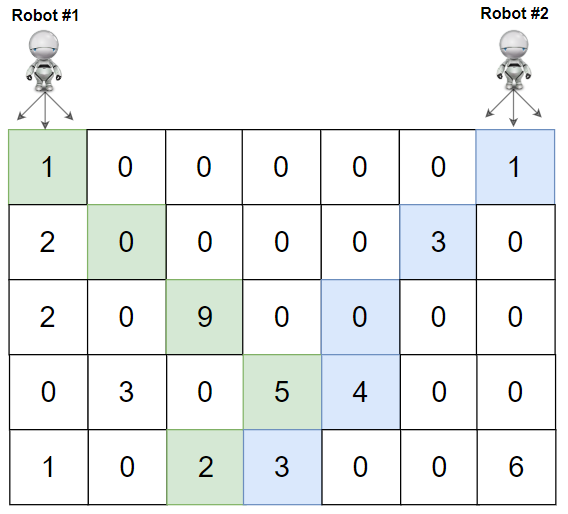1463. Cherry Pickup II
January 07, 2022
Description:
You are given a rows x cols matrix grid representing a field of cherries where grid[i][j] represents the number of cherries that you can collect from the (i, j) cell.
You have two robots that can collect cherries for you:
- Robot #1 is located at the top-left corner
(0, 0), and - Robot #2 is located at the top-right corner
(0, cols - 1).
Return the maximum number of cherries collection using both robots by following the rules below:
- From a cell
(i, j), robots can move to cell(i + 1, j - 1),(i + 1, j), or(i + 1, j + 1). - When any robot passes through a cell, It picks up all cherries, and the cell becomes an empty cell.
- When both robots stay in the same cell, only one takes the cherries.
- Both robots cannot move outside of the grid at any moment.
- Both robots should reach the bottom row in
grid.
Example 1:

1 | Input: grid = [[3,1,1],[2,5,1],[1,5,5],[2,1,1]] |
Example 2:

1 | Input: grid = [[1,0,0,0,0,0,1],[2,0,0,0,0,3,0],[2,0,9,0,0,0,0],[0,3,0,5,4,0,0],[1,0,2,3,0,0,6]] |
Constraints:
rows == grid.lengthcols == grid[i].length2 <= rows, cols <= 700 <= grid[i][j] <= 100
We have a maximum input size of 70*70 = 4900, a loose limit would be $O((mn)^2)$.
Intuition:
- Each round, each robot would go exactly one step down. And they will always move forward until reaching the end.
- In this way, we can describe the status of two robots by a 3-element tuple
(y,x1,x2). Since#y: row #x: col, there are $O(r*c^2)$ combinations
- In this way, we can describe the status of two robots by a 3-element tuple
dp[y][x1][x2]means the maximum cherries collected at this combination- Base Case:
y>=r, x<0 or x>c(out of bounary), return 0 - Transition Equation:
dp[y+1][x1][x2] ={max[y][x1'][x2'] + grid[y][x1]+grid[y][x2] if x1!=x2 else 0} - Time Complexity: $O(rc^29)$
- Space Complexity: $O(r*c^2)$
- To get the answer: find the maximum value in
dp[r-1][x1][x2](traverse)
A Reverse Solution:
Robots start at any grid in the last level, and then they go up until one goes to the left corner, the other go to the right corner.
Transition Equation:
dp[y][x1][x2] ={max[y+1][x1'][x2'] + grid[y][x1]+grid[y][x2] if x1!=x2 else 0}To get the answer:
dp[0][0][c-1]
Code:
1 | class Solution |
Load Comments